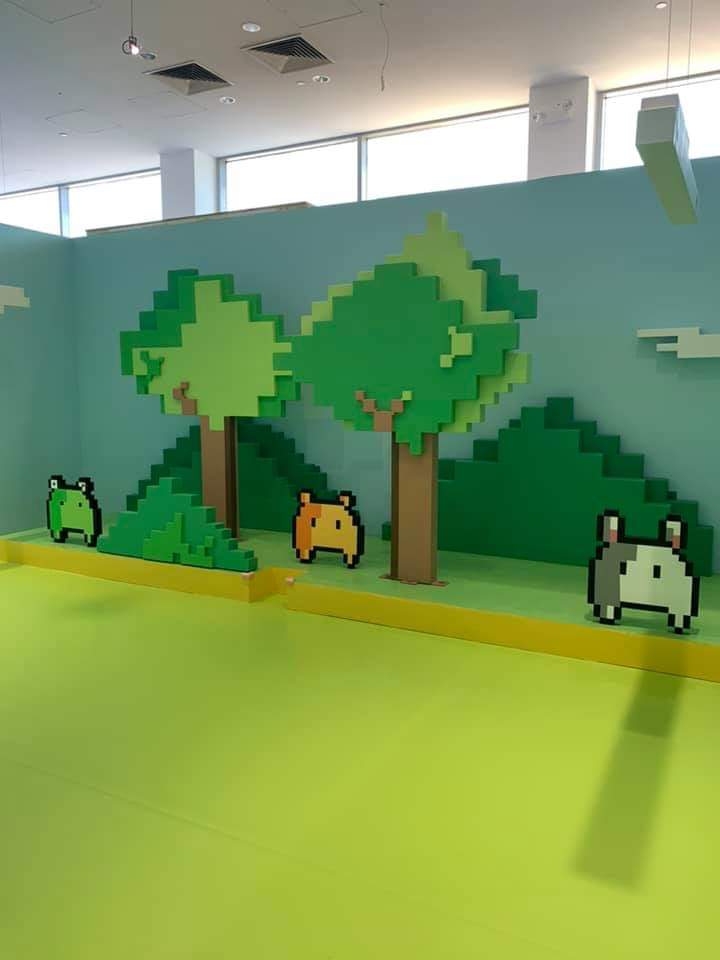By Kathleen Liautaud and Aleah Cole
Pixinity’s colorful pop up art gallery takes a different approach to their guests who are autistic children in New York City.
Pixinity is a pop-up art gallery in Soho, New York City that opened its doors this August. The 3D art gallery was designed by artist Tianyu Qiu who drew inspiration from his autistic relative. His relative’s main source of communication is with computers and pixelated images. Inside the exhibit, there are pixel art sculptures that are inspired by emoticon characters and gaming icons that can be found throughout the exhibition.
Among many pop up art exhibits in New York City, most of their illustrations accommodates children who don not have autism. But, the artist took a different approach in his creation by welcoming autistic children in the exhibit and presenting his wide array of work. In addition, Qiu has collaborated with Autism Speaks, an advocacy organization, and donates a portion of ticket sales ticket sales to aid autism research and patients.
“I wanted to build this digital installation-immersive rooms and everyone can come in and play using these digital elements,” Qiu said.
Pixinity features interactive activities in each room for guests to enjoy physically and acknowledge like most typical art galleries. The exhibit has a large ball pit with foam cubes, hanging pixel sculptures for guests to get behind for a photo, and a like size sculptures to sit on.
Antoinette Canty, the assistant director of the Child and Family Care Center at York, supervises children in diverse areas of enhancing their developmental skills and strengthening their communication with other students and professional staff in the classroom. Also, she experienced teaching an autistic child who was three years old and was about to be four years old about two years ago.
“I had a child who was autistic in my class and the child was very intelligent,” Canty said. “He was able to write and read but he just didn’t give me much eye contact and wasn’t very sociable to other children.
Canty also said that her experience teaching the child was a pleasure for her because the child loved to read.
“He read so many books even though he seemed very timid,” She said. “He wasn’t a child who disturbed other children, he actually shared his thoughts with other children but he didn’t socially engage with other children.”
Margaret Vendreyes, the Department Chairperson of Fine Arts at York College, shared some tips on how autistic people in general can communicate with art pieces.
“To my knowledge, I have a nephew who is autistic, he had not seen my work before but I think he can interact with other art works through its patterns and/or color,” Vendreyes said.
Artist Qiu’s autistic relative that has difficulty with verbal communication, understands digital stimulation on iPads and computers by moving his fingers in a circular motion on the screen.
“I wanted to build this digital installation-immersive rooms and everyone can come in and play using these digital elements,” Qiu said.
There is a glowing dark room where guests can gaze at the glowing lights that are pointed in different directions.
The artist shared a memorable moment when one autistic teenager was affected by his artwork during a visit at Pixinity. He said the teenager came into the exhibit sitting a baby stroller and told him that she never likes to leave.
“She was affected by the colorfulness,” Qiu said. “I handed her a sponge cube and she was playing with it just like how my sister was building the Legos. At that moment, I was almost crying watching her stand from her stroller walking to the art. To me that’s amazing.”
The structure of the classrooms in the Child and Family Center at York College consists of three classrooms and an open classroom with three lead teachers and two assistant teachers. Some of children who are autistic are not separated from other students.
“They are open to all of the activities that the children are able to do,” Canty said. “But if they aren’t fit for this program, we would notify their families and refer them to the Committee for Preschool Special Education and then they may have to go to a smaller setting.”
In addition, the environment of the classrooms in the Child and Family Center is not set for highly severely autistic children. It is a main screen classroom. The child she taught was there for a year and a half but she realized that he needed a smaller setting. Thus, the child was transferred to another program.
In Pixinity, there is a room that features sculptures that have only one facial feature; guests are encouraged by staff to take a photo with a sculpture each portraying a different emotion.
“Sometimes art can be a very pretty thing-a fun thing to look at-or it can be collected by billionaires,” said Qiu. “Art has different meanings. What I’m trying to do is create this world that people can enjoy. My personal practice is using a lot of technology.”
“I’m an artist that creates installation sculptures and combine them with video and projection,” he added. “For me the artwork is always the artist’s tool to communicate with the viewers.”
In addition, the art exhibit has a computer-designed room that consists of microcomputer icons that are projected onto a spinning fan and change shapes with every few spins.
“A lot of people come in fashionable outfits so they feel like this is the best place to take pictures,” said Brittany Grant, an employee who works at Pixinity.“Taking pictures in art exhibit has been a popular trend on social media because Influencers and fashionistas alike take advantage of the unique spaces to pose for photos and social media.”
A printed version of this story failed to acknowledge Kathleen Liautaud’s contribution towards this story. A correction has been made in the story to reflect that.


